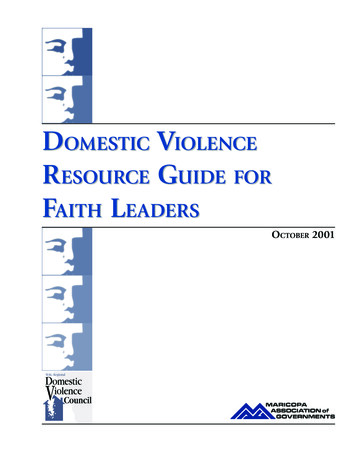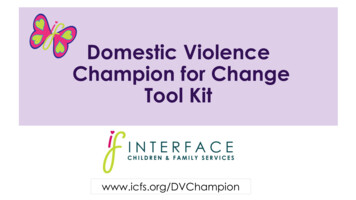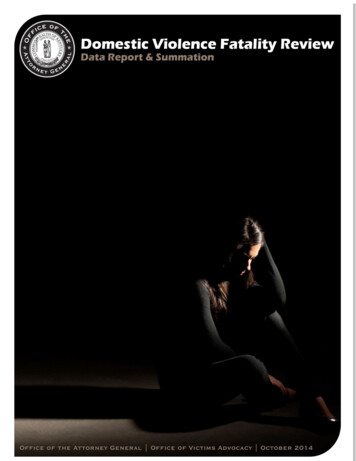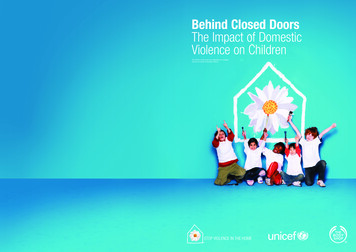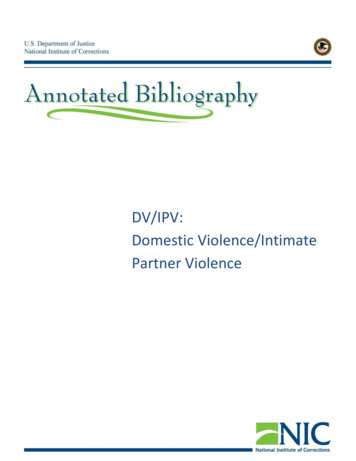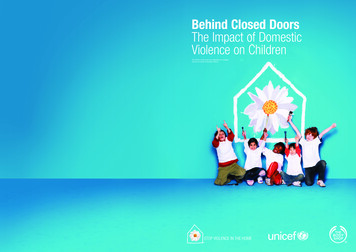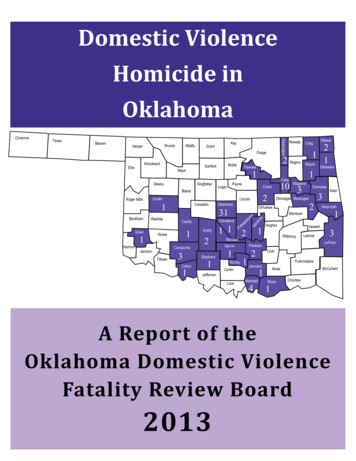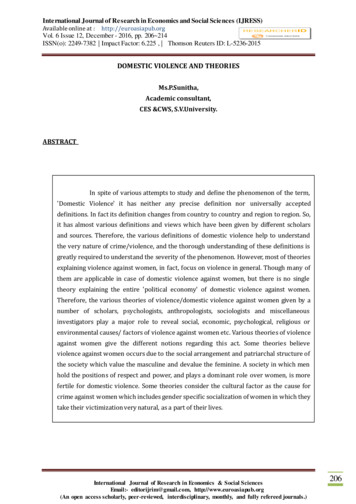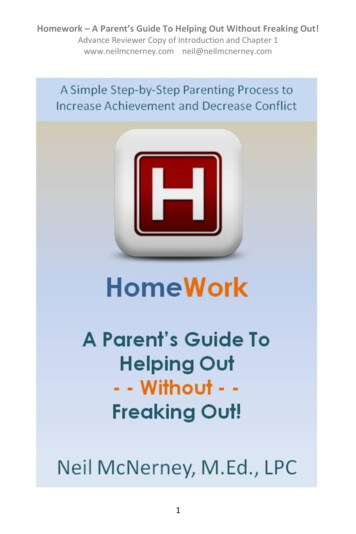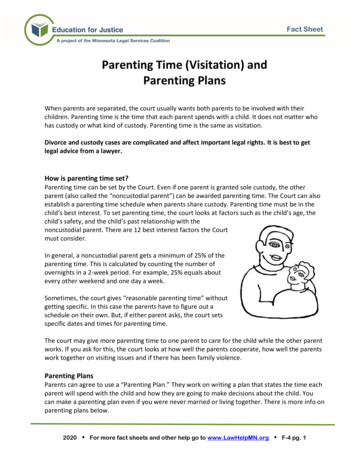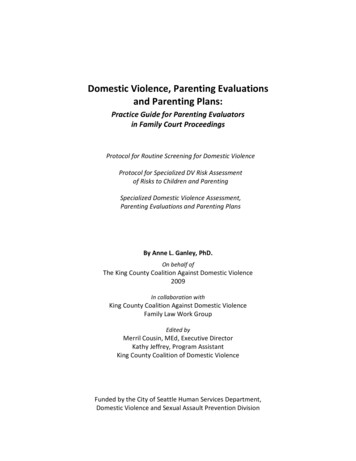
Transcription
Domestic Violence, Parenting Evaluationsand Parenting Plans:Practice Guide for Parenting Evaluatorsin Family Court ProceedingsProtocol for Routine Screening for Domestic ViolenceProtocol for Specialized DV Risk Assessmentof Risks to Children and ParentingSpecialized Domestic Violence Assessment,Parenting Evaluations and Parenting PlansBy Anne L. Ganley, PhD.On behalf ofThe King County Coalition Against Domestic Violence2009In collaboration withKing County Coalition Against Domestic ViolenceFamily Law Work GroupEdited byMerril Cousin, MEd, Executive DirectorKathy Jeffrey, Program AssistantKing County Coalition of Domestic ViolenceFunded by the City of Seattle Human Services Department,Domestic Violence and Sexual Assault Prevention Division
Permission to Reprint or Adapt the Contents ofDomestic Violence, Parenting Evaluations and Parenting Plans:Practice Guide for Parenting Evaluatorsin Family Court ProceedingsThe content of this publication may be adapted and reprinted with permission of theKing County Coalition Against Domestic Violence. Any adaptation or reprinting mustbe accompanied by the following acknowledgement:“This material was adapted from the King County Coalition AgainstDomestic Violence’s 2009 publication entitled “Domestic Violence,Parenting Evaluations and Parenting Plans: Practice Guide forParenting Evaluators in Family Court Proceedings.” The guide wasauthored by Anne Ganley, PhD. Production of the practice guide wasmade possible by a grant from the City of Seattle.King County Coalition Against Domestic Violence1419 S. Jackson St. #103Seattle, WA 98144Phone: 206.568.5454Fax: 206.568.5462www.kccadv.orginfo@kccadv.org
DOMESTIC VIOLENCE, PARENTING EVALUATIONS AND PARENTING PLANS: A Practice Guide for Parenting Evaluators in Family Court ProceedingsTABLE OF CONTENTSPrefaceAcknowledgements . iiiTerms Used In This Practice Guide . vIntroduction . 1Section One: Overview . 9 Domestic Violence, Impact on Children and Parenting, Use of Behavioral Definition of Domestic Violence, Routine Screening for Domestic Violence Specialized Domestic Violence Assessment of Risks to Children and Parenting DV Assessment-based Parenting Plan Recommendations Safety First: Safety Strategies for Conducting Parenting EvaluationsSection Two: Protocol for Routine Screening for Domestic Violence . 27 Purpose of Screening Interview Questions and Procedures Other Data: Review of Case Materials and Collateral Contacts Documentation and Report Format Templates for Routine Screening for Domestic ViolenceSection Three: Protocol for Assessing and Responding toDomestic Violence Imminent Danger . 47 Assessing Imminent Danger to Adult Victim, Child, Others, Perpetrator Crisis Response Documentation and Report Format TemplatesSection Four: Protocol for Specialized Assessment of Domestic Violence Risk(s) toChildren and Parenting . 59 Domains of Specialized DV Assessment Interviewing Adult Victims, DV Perpetrator, Children Scenario and Directed Questions Interview Formats Other Sources of Data: Review of Case Materials and Collateral Contacts Documentation and Report Format Templates for Specialized Assessment of Domestic Violence Risk(s)Section Five: Differential Parenting Plan Recommendations based on theSpecialized Assessment of Domestic Violence Risks to Children and Parenting . 94 Elements to Consider for Parenting Plans for DV Cases Recommendations for Parenting Plans for DV Cases Templates for types of DV, PPP Screening, and Parenting Plan ProvisionsSection Six: Suggested Format for Domestic Violence in Parenting Evaluation Report . 115 Writing the DV Section of the Parenting Evaluation report Template for the Format for the DV Section of the Parenting Evaluation ReportReferences . 119Online Resources for Parenting Evaluators, Family Law Attorneys & Judicial Officers .121Appendix A: DV Perpetrators Tactics: Use of Children to Control Adult Victim .126Appendix B: Attorney/ Courts Checklists .127Anne L. Ganley, PhD, For King County Coalition Against Domestic Violence, 2009
DOMESTIC VIOLENCE, PARENTING EVALUATIONS AND PARENTING PLANS: A Practice Guide for Parenting Evaluators in Family Court ProceedingsPREFACEThis practice guide was developed by Dr. Anne Ganley as part of a project coordinated by theKing County Coalition against Domestic Violence (KCCADV), and funded by the City of Seattle.The goal of the project is to assist parenting evaluators in King County to more effectively andconsistently integrate an understanding of domestic violence into their practice. Projectactivities included: Reviewing recent literature related to parenting evaluations in family law cases involvingdomestic violence. Developing a practice guide for evaluators containing model guidelines, procedures andother materials detailing how to address domestic violence in parenting evaluationprocedures and reports. . Developing a training program on the parenting evaluation guidelines. Presenting two trainings in 2008 on the model guidelines, one for parenting evaluatorsand one for family law attorneys.This project grew out of work done by the KCCADV over the last several years. In 2005, theKCCADV conducted a qualitative research project to describe the experiences of batteredwomen with the family law system in King County, WA. The report from that study, I JustWanted to Be Safe (available at www.kccadv.org/reports), identified parenting evaluations(conducted by CASA volunteers, Guardians Ad Litem, and private evaluators) as one areawhere there were often problems. Both service providers and survivors felt that parentingevaluators often do not appear to understand domestic violence, or don’t have the tools theyneed to effectively assess and address domestic violence in the context of their evaluations. Asa result, both the safety and economic stability for survivors and their children are potentiallycompromised. In May 2007, a group of King County leaders attended a summit to discussconcerns about parenting evaluations in the context of domestic violence. Both the 2005report and the 2007 Summit called for the development of model guidelines and training forthose responsible for ordering, providing and using parenting evaluations in the context ofdomestic violence.In response to these recommendations, City of Seattle leaders provided funding for a year-longproject to address this issue. KCCADV was chosen to coordinate the project. The KCCADVFamily Law Work Group provided input and guidance throughout the project and severalstudents from local universities conducted portions of the literature search. Dr. Anne Ganleywas hired to write the practice guide, and develop and implement the training programs.Anne L. Ganley, PhD, For King County Coalition Against Domestic Violence, August 13, 2009i
DOMESTIC VIOLENCE, PARENTING EVALUATIONS AND PARENTING PLANS: A Practice Guide for Parenting Evaluators in Family Court ProceedingsThis document can serve as a guide for professionals charged with conducting parentingevaluations in family law cases. It is a first step to improving the consistency and effectivenessof parenting evaluations in cases that involve domestic violence. Future activities of theproject may include: additional training for evaluators, attorneys, judicialofficers, and victim advocates on the practice guidelines; evaluating the effectiveness of thepractice guide and training models; advocating for policies that mandate the use of and/ortraining about the guidelines for professionals conducting parenting evaluations in cases thatinvolve domestic violence; and delivering the practice guide and training throughoutWashington State (and nationally). Additional funding would be needed to accomplish thesetasks.Ultimately, we hope this work will result in long term improvements in the family law system’sability to facilitate outcomes that effectively protect the safety and interests of adult domesticviolence survivors and their children. In addition, we hope this work will allow for safe contactbetween the battering parent and the children, when and in a manner that is appropriate, andwill promote safe and responsible parenting in the best interests of children.Merril Cousin, Executive DirectorKing County Coalition against Domestic ViolenceDecember 2008Anne L. Ganley, PhD, For King County Coalition Against Domestic Violence, August 13, 2009ii
DOMESTIC VIOLENCE, PARENTING EVALUATIONS AND PARENTING PLANS: A Practice Guide for Parenting Evaluators in Family Court ProceedingsACKNOWLEDGEMENTSWe would like to thank everyone who was involved in making this project a reality. Pleasenote that while these individuals provided information and/or other support for this work;they did not review the final document and do not necessarily endorse its content.KCCADV Family Law Work Group MembersJennifer Anderson, Eastside Domestic Violence ProgramSusan Chua, King County Bar AssociationNikki Dally, Domestic Abuse Women’s NetworkElizabeth Gay, King County Office of Judicial AdministrationBeth Helm, Northwest Justice ProjectJennie Laird, AttorneyJorene Moore, King County Family Court ServicesCiara Murphy, Salvation Army Domestic Violence ServicesLinda Olsen, Seattle Domestic Violence and Sexual Assault Prevention OfficeTracee Parker, Safe Havens Supervised Visitation ProgramCommissioner Les Ponomarchuk, King County Superior CourtKrystal Starling, Domestic Abuse Women’s NetworkCommissioner Meg Sassaman, King County Superior CourtLeslie Savina, Northwest Justice ProjectSandra Shanahan, King County Protection Order Advocacy ProjectPam Smith-Mentz, New BeginningsDave Wight, Antioch UniversityStudentsSkultip (Jill) Sirikantraporn, Antioch UniversityJulie Stroemel, Argosy UniversityNina Tantraphol, University of Washington, Evans School of Public AffairsDave Vandergrift, Antioch UniversityRachel Wilhoit, Seattle University School of LawAnne L. Ganley, PhD, For King County Coalition Against Domestic Violence, August 13, 2009iii
DOMESTIC VIOLENCE, PARENTING EVALUATIONS AND PARENTING PLANS: A Practice Guide for Parenting Evaluators in Family Court ProceedingsTERMS USED IN THIS PRACTICE GUIDEChild Maltreatment: physical abuse, sexual abuse or neglect of a child that constitutes a clearand present danger to a child’s health, welfare or safety.Caregiver: Legal parent, custodian, or person acting “in loco parentis”.Child(ren): Any person under the age of eighteen years of age. (RCW 26.44.020 (6))Domestic Violence (DV) a.k.a. Intimate Partner Violence ( IPV): the behavioral definitionof domestic violence: “ domestic violence is a pattern of assaultive and coercive behaviors,including physical, sexual, and psychological attacks, as well as economic coercion, that adultsor adolescents use against their intimate partners” (Domestic Violence Manual for Judges2006) DV perpetrators’ abusive tactics include, but are not limited to, physical abuse, sexualabuse, terrorizing tactics (e.g. stalking, displaying weapons, use of or threats of violenceagainst victim, children, others, and/or property), physically and/or psychologically isolatingthe victim, repeated attacks against the victim’s competence, alternating use of indulgences,control of family funds and resources, and use of children to control the adult victim. Theperpetrator’s use of physical force against persons or property or the use of conduct thatestablishes credible threat of physical harm (i.e. terrorizing tactics) combined with othercontrolling tactics are key elements of the behavioral definition of domestic violence.Domestic violence tactics range from life-threatening to less severe; some are criminal, butmany are not. The effect of the overall pattern of assaultive and coercive behavior is toincrease the abuser’s power and control in that relationship. Legal definitions of domesticviolence vary somewhat from the behavioral definition depending on the court (criminal vs.civil) and the proceeding. See Domestic Violence Manual for Judges 2006, Chapter 2 for fulldiscussion of behavioral definition and legal definitions of domestic violence.Domestic Violence Victim: (a.k.a. Adult Victim, DV Survivor): the adult or adolescent whois the recipient of the DV perpetrator’s pattern of coercive and controlling conduct (see list ofbehaviors and tactics in above definition of DV). The adult victim may or may not be the legalparent or the “in loco parentis” caregiver of the child and may or may not be the parent in theparenting plan proceeding. Sometimes the term “DV survivor” is used to highlight that theadult victim may have many strengths and positive parenting skills even while beingvictimized by the DV perpetrator.Domestic Violence Victim Services: specialized services for victims of domestic violence andtheir children including shelter, transitional housing, support groups, legal and systemsadvocacy, child witness groups, parenting after domestic violence classes, and DV supervisedvisitation centers. Culturally specific DV service programs are available for faith communities,Anne L. Ganley, PhD, For King County Coalition Against Domestic Violence, August 13, 2009v
DOMESTIC VIOLENCE, PARENTING EVALUATIONS AND PARENTING PLANS: A Practice Guide for Parenting Evaluators in Family Court Proceedingsethnic or racial groups, refugee and immigrant groups, GLBT communities, survivors withdisabilities, and others. The services may be for victims living in DV-specific housing or theymay be for victims living in the community. There is a great deal of variety from community tocommunity on which services are available for which specialized population. For a completeupdated list of King County Services, please see http://www.kccadv.org/counseling.html.Domestic Violence Advocate: a trained staff person who works in a program that providesservices to domestic violence victims, including those services listed above. DV advocatesinclude both community -based advocates who are based in non- profit domestic violenceprograms, and system- based advocates who are based in and employed by governmentsystems, such as a prosecutor’s office or police department.Domestic Violence Perpetrator: (a.k.a. DV Abuser), a person in an intimate relationshipwho uses a pattern of assaultive and coercive behaviors to control their partner. The DVperpetrator uses a wide variety of tactics (see above definition of domestic violence), rangingfrom criminal and/or physically damaging acts to less overt, less physically severe tactics. TheDV perpetrator may or may not be the legal parent or the “in loco parentis” caregiver of thechild and may or may not be the parent in the parenting plan proceeding.Domestic Violence Perpetrator Treatment Program (a.k.a.) Domestic Violence Batterer’sIntervention or Treatment Program): an intervention program specifically designed to stopintimate partner violence. In Washington State, DV perpetrator treatment programs must becertified by DSHS and must comply with the minimum standards in the WashingtonAdministrative Code 388-60. The standards outline program requirements regarding victimsafety, contact with adult victim, clinical assessments of perpetrator, group work, use of nonvictim blaming strategies, completion criteria, staff education and experience, andcoordination with other community systems. DV Perpetrator Intervention Programs arerequired to include information about the impact of domestic violence on children. Successfulcompletion of the program is based on the successful completion of set objectives and is notmerely time based. Minimum time accountability to a program is for one year, with minimumparticipation in weekly sessions for 6 months followed by minimum of once monthly sessionsfor an additional 6 months. For many participants, successful completion may involveattending weekly groups for the entire year. Successful completion is based on demonstratingbehavioral changes as specified in the behavioral objectives of the program (e.g. “responsibilityplan”) and not on attendance alone. For a list of WA state certified programs and the WAstandards see . In addition to these DVperpetrator treatment programs, there are separate programs for parenting after domesticviolence. See online resource list for King County programs on page 111.Domestic Violence Relevant Legal Statutes: see 2006 Judges Manual for complete cites anddetails related to DV-specific orders such as D.V. limiting factors for parenting plans, CivilProtection Order, Criminal No Contact Order, Restraining Order in Dissolution Proceedings,Protection Order for Stalking, and Anti- Harassment Orders.Anne L. Ganley, PhD, For King County Coalition Against Domestic Violence, August 13, 2009vi
DOMESTIC VIOLENCE, PARENTING EVALUATIONS AND PARENTING PLANS: A Practice Guide for Parenting Evaluators in Family Court ProceedingsDomestic Violence Safety Plan: a process of thinking through with the adult victim how toincrease safety for both the adult victim of domestic violence and their children. DV Safetyplanning addresses both immediate and long terms risks to both the adult victim and children,and is based on knowledge about the specific pattern of the DV perpetrator’s tactics and theprotective factors of the adult victim, children, community and DV perpetrator.Domestic Violence Screening Protocol: a routine inquiry protocol used for all cases toidentify whether or not DV is present as well as to identify the adult DV victim and DVperpetrator whenever domestic violence is present. It addresses the basic screeningquestions:Is there DV, or not, in this case?If DV is present, then who is the adult DV victim? And who is the DV perpetrator?Domestic Violence Specialists: professionals who have DV expertise from working in DVvictim service programs or DV perpetrator intervention programs or from conducting DVevaluations. They have expertise in assessing the dangerousness of DV, safety planning,interview skills with victims, children, or perpetrators, and the impact of domestic violence onadult victims, DV perpetrators, children, and parenting.Intimate Partner Violence (IVP): (a.k.a. Domestic Violence, DV): a term sometimes used tofocus on the most common form of domestic violence, which is between adult or adolescentintimate partners, rather than on the domestic violence between non-intimate adult householdmembers (see legal definition of household members in 2006 Judges DV Manual, Chapter 2).Specialized Assessment of DV Risks to Children/Parenting Posed(a.k.a Specialized DV Assessment): a protocol for conducting the specialized assessmentrisks to children and parenting posed by the identified domestic violence . This specialized DVassessment process involves gathering information about and a consideration of the following: a detailed description of perpetrator’s pattern of assaultive and coercive tactics againstthe adult victim, including but not limited to, physical assaults, sexual assaults,psychological attacks, economic coercion, and the use of children to control the adultvictim the impact of domestic violence on the adult victim the impact of the domestic violence on the children an assessment of lethality (dangerousness) of the domestic violence an assessment of protective factors of the adult victim, children, DV perpetrator, andcommunity that mitigate risk to the children from DVParenting Evaluator (Evaluator): Professionals who have specialized knowledge and skillsfor conducting parenting evaluations for family court proceedings. In King County parentingevaluations for family court may be done by Family Court Services social workers; privatepractice psychologists, psychiatrists, and social workers; Guardians Ad Litem evaluators orspecially trained Family Law CASA evaluators.Anne L. Ganley, PhD, For King County Coalition Against Domestic Violence, August 13, 2009vii
DOMESTIC VIOLENCE, PARENTING EVALUATIONS AND PARENTING PLANS: A Practice Guide for Parenting Evaluators in Family Court ProceedingsPrimary Aggressor DV: when both parties use physical force during the episode, the primaryaggressor is determined by a consideration of the following factors: domestic violence historybetween the parties, relative size or physical strength of involved parties; comparative extentof injuries or serious threats creating fear of physical injury; did one act in self-defense?; whois afraid of whom? Primary does not necessarily mean who struck first.Professionals contributing to parenting evaluations either to the court directly or to theparenting evaluator: DV evaluators, DV victim service providers, DV perpetrator interventionproviders, treatment providers for either parent or children, school personnel, child welfareworkers, GALS, CASA workers or specialized evaluators (substance abuse, sexual deviancy,etc). They may provide partial input either to the court or to a parenting evaluator regardingDomestic Violence issues, children and parenting.Anne L. Ganley, PhD, For King County Coalition Against Domestic Violence, August 13, 2009viii
DOMESTIC VIOLENCE, PARENTING EVALUATIONS AND PARENTING PLANS: A Practice Guide for Parenting Evaluators in Family Court ProceedingsINTRODUCTIONThe purpose of these practice guidelines is to improve the quality of parenting evaluations inthose family law cases that involve the very complex and challenging issues of domesticviolence (DV). These guidelines integrate knowledge about domestic violence and its impacton children and parenting into the parenting evaluation process. This guide focuses onparenting evaluator practice: how to conduct interviews, how to evaluate the specific DVrelated information gathered, and how to apply the findings from a specialized DV assessmentto recommendations for DV specific parenting plans.This practice guide is a continuation of what has emerged from the domestic violence andparenting evaluation fields in the past 20 years. The Family Court Review Journal,1 produced bythe Association of Family and Conciliation Courts devoted its July 2008 issue to the topic ofdomestic violence and parenting plans in family court proceedings. The issue brought togetherleading US and Canadian expertise from the fields of domestic violence, parenting evaluations,and family courts. Those experts make a clear call for routine screening for domestic violenceand for a more complex assessment of the domestic violence issues in order to usedifferentiated approaches in parenting plans for domestic violence cases (Jaffe, Johnston,Crooks, & Bala, 2008; Frederick, 2008). This call for domestic violence screening andspecialized assessment is consistent with findings of the KCCADV report I Just Wanted to BeSafe: Battered Women’s Experiences with the Family Law System in King County (2005).2Literature searches conducted as part of this 2008 project yielded published materialsprimarily from the past five years. 3 The searches revealed certain gaps in resources availableto parenting evaluators addressing domestic violence issues in their practice. The literature(both research and practice articles) currently covers three general topics: (1) domesticviolence and its impact on children and parenting, (2) parenting evaluations in general, and (3)more recently, articles highlighting the overlapping issues of the two fields. 4 However, thereis little written specifically on how to address domestic violence within a parenting evaluation.The gaps are: A lack of specific guidance (protocols or tools) for routinely gathering informationrelevant (1) to determining whether or not there is DV, and (2) for determining who the1 See Journal Vol 46, No 3, and July 2008 for references to current research. The Association of Family and Conciliation Courtsalso co sponsored a conference on same topics held in May 2008 in British Columbia.2available3at www.kccadv.org/reportsSee Acknowledgements for list of students compiling the literature search.4 Ackerman, M.J., 2006 Clinician’s Guide to Child Custody Evaluations, John Wiley & Sons, Inc, Hoboken, NJ. Ackermandevoted 9 pages to the topic in this third edition of book.Anne L. Ganley, PhD, For King County Coalition Against Domestic Violence, August 13, 20091
DOMESTIC VIOLENCE, PARENTING EVALUATIONS AND PARENTING PLANS: A Practice Guide for Parenting Evaluators in Family Court Proceedingsadult victim is and who the DV perpetrator is in cases where domestic violence isidentified. A lack of specific practice guidance on how to assess the complexities of identifieddomestic violence in order to make recommendations for parenting plans in the bestinterests of children. A lack of guidance on how to apply the findings of a specialized DV assessment todifferential parenting plans for families with domestic violence issues.This practice guide is designed to address those gaps.The guidelines and protocols draw heavily on domestic violence screening and assessmentprotocols used in health care, in child welfare, and in the domestic violence fields.5 Withinthose fields both routine screening and the specialized DV assessment protocols are widelyaccepted as standard practice to improve responses to families with domestic violence issues.There is some research on routine screening for DV in health care settings 6 and research onboth routine screening7 and specialized assessment of DV risks to children in child welfare.8The DV specific interview protocols to follow are designed to reduce defensiveness,minimization, and denial and to promote self disclosure from both parties. They focus onconduct. They are firmly grounded in the behavioral definition of domestic violence. In DVcases, self disclosure about one’s own conduct can lead to less of the “he-said-she-said”dynamic that occurs too often with high conflict parenting evaluations. In DV cases, the realityis that both adult DV victims and perpetrators frequently talk about the abusive conduct andits impact on the family, but they do not always consider it domestic violence. And just asimportantly we the evaluators often fail to recognize the reported conduct as domesticviolence, and therefore, do not “hear” what the parties are revealing to us. The protocolsdescribed in this guide are designed to overcome those obstacles.These practice guidelines are recommended for the professionals conducting parentingevaluations in a variety of family law proceedings.Developed by this the author and other professionals over the past 20 years, see on line resource list for Family Violence PreventionFund materials as examples.56See www.Endabuse.org for current research on routine screening for domestic violence in health settings.See the Journal: Family Court Review, July 2008, vol 46, No 3 for further discussion of research and practice issues related to routinescreening and specialized DV assessment in parenting evaluations.7Portions of this guide were drawn from the Domestic Violence Practice Guide for Child Welfare Workers (2009 in press), Children'sAdministration, Washington State Department of Social and Health Services, contributing authors: Anne Ganley, PhD and MargaretHobart, PhD for Washington State Coalition Against Domestic Violence (WSCADV ).8Anne L. Ganley, PhD, For King County Coalition Against Domestic Violence, August 13, 20092
DOMESTIC VIOLENCE, PARENTING EVALUATIONS AND PARENTING PLANS: A Practice Guide for Parenting Evaluators in Family Court ProceedingsWhile parenting evaluations are typically used for the development of court orderedpermanent parenting plans, these practice guidelines may also be used when professionalsgather information relevant for temporary parenting plans, mediated parenting plans, or formodifications of existing parenting plans. They are recommended for use by the variousparenting evaluators practicing in King County family law proceedings, such as: Family Court Services parenting evaluators Private practice parenting evaluators/specialists (Ph.D., MSW, MDs) GAL (attorneys or mental health specialists) evaluators Family Law CASA evaluatorsThe practice guidelines may also be used by other professionals called upon to give partial, butvaluable input either to the court or to a parenting evaluator regarding domestic violenceand/or parenting issues: Domestic violence evaluators DV victim service providers DV perpetrator intervention providers Treatment providers for either of the parties or for the children GAL and CASA workersThis domestic violence specific practice guide is supplementary.It is beyond the scope of this project to produce a comprehensive practice guide for parentingevaluators. These guidelines focus exclusively on the topic of domestic violence withinparenting evaluations, and consequently they are designed to be used as a supplement toalready existing parenting evaluation materials 9 and to be implemented within the context ofethical and professional guidelines and/or standards for parenting evaluations. 109 For a comprehensive description of parenting evaluation process see Ackerman, 2006; and Gould, J.W. & Martindale, D. A. 2007, TheArt and Science of Child Custody Evaluations, New York: Guilford.
Julie Stroemel, Argosy University Nina Tantraphol, University of Washington, Evans School of Public Affairs Dave Vandergrift, Antioch University . Culturally specific DV service programs are available for faith communities, DOMESTIC VIOLENCE, PARENTING EVALUATIONS AND PARENTING PLANS: A Practice Guide for Parenting Evaluators in Family Court .
